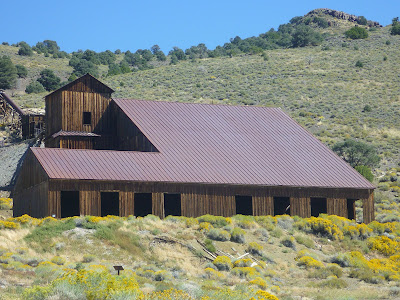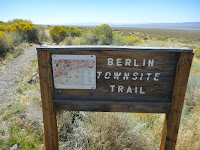 |
| The largest structure in the townsite: the Berlin Mill with the ore chute pointing uphill into the direction of the mine entrance |
The temporary existence of Berlin as a gold and silver boom town reflects the short time of the briefly prospering mining business: Berlin was established in 1897 and largely abandoned by 1911.
Visiting Berlin today and walking along the Berlin Townsite Trail — a 0.9-mile-long loop trail — is a great start to travel back in time and explore how life might have been back then between mountain ranges and desert valleys around 1900. Here, I show snapshots I made in September 2023, showing buildings and sites. The tour starts at the Visitor Center and ends at the collapsed Clubhouse. |
| Berlin Historic Park Visitor Center |
Mrs. Phillips Home
Mrs. Kate Phillips lived here until 1907. She then moved to Ione and opened a boarding and lodging house.
Later, Bill and Mack Foster resided in this building for about twenty years. During that time they prospected a wide area and also leased on company property. Later they gardened and raised goats. Bill got sick and was taken to Tonopah where he died in 1953. In 1954, Mark died here of a heart attack.
In his book “Odyssey of a Desert Prospector”, Hermann W. Albert's description of the house in which he lived, fits the appearance of his building at the time. Mrs. Phillips moved to Ione previously and it was very likely that Albert lived here when he was working for the company.
 |
| Mrs. Phillips House |
The Berlin Mill
This building was a beehive of activity while Berlin was in its heyday.
One man tended to the primary crusher and did other odd jobs, another tended the 30 stamps and the concentration tables, and a third man fired the five boilers and looked after the four steam engines. One engine powered the primary crusher and the stamps, another powered the concentrating tables, the third drove the direct current dynamos that supplied electricity for lights, and the fourth engine was combined with a compressor that furnished air to run the drilling rigs and pumps in the mine.
The area between the mill, machine shop and boarding house was piled high with cord wood used to fuel the boilers. Mine rail tracks were laid between the long piles of wood and flat rack trucks rolled on the tracks to bring wood close to the boilers.
 |
| Berlin Mill |
 |
| A look inside the mill |
The forest you see around Berlin is mostly second growth. The Guide explains that during the activity at the Berlin Mine, nearly every large pinyon and juniper between Grantsville and Ione was felled to feed the boilers and steam engines at the mine and mill. In the Berlin Mill picture you can spot some trees up the hills in the background.
Ore processing in the mill always left mill tailings behind, which still contained gold. The tailing values were recovered in 1910 by using a cyanide plant .
Machine Shop
This building contained the blacksmith shop, and was equipped with power driven drill presses, and lathes, etc. Therefore, it was called the machine shop. The crew of mechanics that worked here kept all the mine and mill machinery running smoothly.
Occasionally a passing automobile that had broken down was towed to its door to be put into running condition again.
 |
| Machine Shop |
Obviously, some mining tools and machinery is displayed around. But the Guide says that all of the major equipment and machinery was sold and hauled away during the scrap metal drives during Worl War II.
Stage Station
The stage driver and his horses were housed under one roof in this building. A partition made of lumber separated the dwelling section from the barn. A small corral was attached to the south section and the door leading into the barn could be closed in cold weather.
The men who drove stage from 1904 until 1924 were John Mullin. Ed Dieringer and Alex Dyer.. Alex used horses until 1915. On his first trip by Model T, the car quit him at the Dieringer Ranch. He caught a ride into Ione for help, and Albert Mayette and Firmin Bruner drove him back to his car and got it started.
 |
| Stage Station |
Assay Office
Samples of rock and ore from the mine and samples of concentrates from the mill were processed (assayed) here to determine the amount of values they contained. The furnace in this assay laboratory used charcoal because it was the only clean burning fuel produced locally.
The night watchman used this office to warm himself and to rest in after each trip through town on lookout for thieves and fires. He also ate his midnight lunch here. The watchman's name was Mr. Doolan.
 |
| Assay Office |
The Clubhouse
The two-story building that stood here was called the “Clubhouse”. It might have been erected to house the mine and mill office. But during the years from 1906 to 1908, it was used as quarters for visiting company officials and local supervisors that did not have families. The bedrooms were upstairs and the lower floor was a lounge.
In the years following 1945, someone removed lumber from the partition walls, thus weakening the building, and it finally collapsed.
[Text by Firmin Bruner, a resident of Berlin - 1904]
 |
| What has been left of the “Clubhouse” |
According to the Guide, alcohol and drinking was not permitted in Berlin. I wonder what visitors and supervisors did in their free time (if there was any) in the lounge? Did they frequent the four saloons located nearby, outside town?
Getting there
From Reno, take I-80 to Fernley. Take exit 46 and continue east on Highway 50. Pass through Fallon and continue to the Middlegate Junction. Turn right onto Route 361 and go south for about 30 miles toward Gabbs. Take a left onto Nevada Route 844 and drive about 16 miles to the park entrance.
Expect your travel time to be 4 hours. Maybe, a little less. Or more, if you take stops along your route — for example, at the Grimes Point Archaeological Site southeast of Fallon.
References and further reading
Berlin State Park. Berlin Town Guide, funded by the Wilhelm Hoppe Family Trust. Available for free at the Berlin Visitor Center (Mine Superintendent's House).
Berlin. Forgotten Nevada. URL: https://forgottennevada.org/sites/berlin.html.
Berlin, Nye Country. Nevada Expeditions. URL: https://www.nvexpeditions.com/nye/berlin.php.
Deborah Wall: Berlin-Ichthyosaur park offers a stunning look at history. Las Vegas Review-Journal, May 15, 2017. URL: https://www.reviewjournal.com/local/local-columns/deborah-wall/berlin-ichthyosaur-park-offers-a-stunning-look-at-history/.
Eric Cachinero: Mine Mechanics. Nevada Magazine, January - February 2019.URL: https://nevadamagazine.com/issue/january-february-2019/8260/.
Note: all listed websites were accessed on September 30, 2023.
Keywords
Berlin Mine, turn-of-the-century mining town, mining history, central Nevada.














